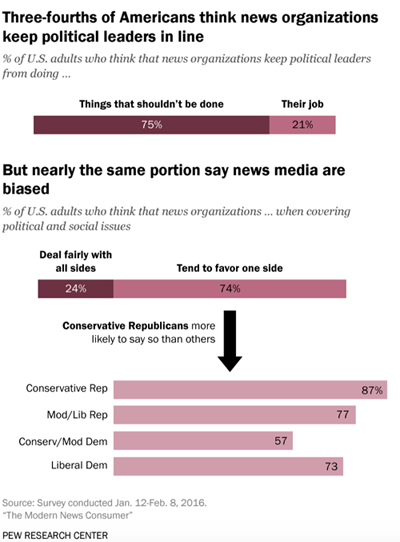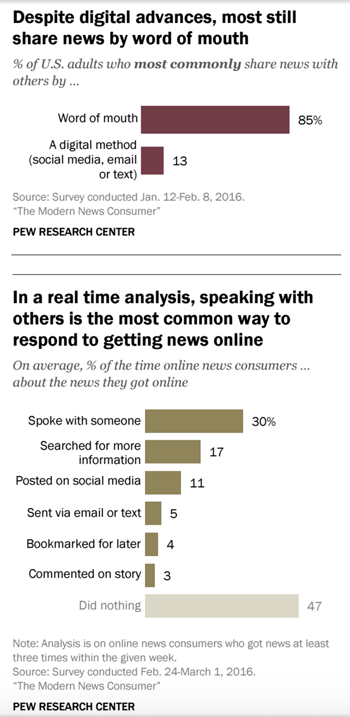A new Pew Research study of news consumption finds the transformation of where the U.S. public gets its news is well along, but traditional attitudes persist.
Even as they are encountering news through social media or reading it on smartphones, consumers value established news organizations as relatively more trustworthy.
Of more than 4,500 consumers surveyed earlier this year, three-quarters said that they continue to value the watchdog role of the media. They “think that news organizations keep political leaders in check — preventing them from doing things they shouldn’t be doing.”
Paradoxically, though, roughly the same proportion think that news organizations are biased politically — “tend to favor one side.” Conservative Republicans were especially likely to perceive media bias.

(Screenshot, Pew Research Center)
You can read that as applauding watchdog digging, even if it comes with a side of political slant. Or maybe the implication is that news organizations are losing the public’s faith in their basic mission because of the perception of bias and ought to be addressing that problem.
A second set of questions dealt with news on social media, and Pew’s general finding was that “while many Americans get news from social media, few social media users are heavily engaged with news there.”
Besides lighter engagement, social media scored especially low on a measure of trust. Only 4 percent said that they have a lot of trust in what they read or watch on social media platforms — though another 34 percent indicated they have at least some trust.
“Digital news is still in its adolescence,” Amy Mitchell, lead author of the report and director of journalism research at Pew told me in a phone interview.
The survey also confirmed earlier work showing a substantial number (57 percent) of consumers sill most often get news from television. These users mainly prefer actual TV’s rather than watching on other devices. A downside for TV, however, is that its audience skews older.

(Screenshot, Pew Research Center)
By contrast the survey found readers increasingly prefer digital — only two in 10 still often get news from printed newspapers, a decline of 7 percentage points since a similar survey was done in 2013.
Family and friends play a role in news consumption as well. About two-thirds of those surveyed said that they considered those personal contacts one important source for finding about news, online or off.
A second, follow-up survey of digital users looked for quick reactions to news items they had seen in the last two hours. The most common reaction was to tell someone about it — as opposed to liking, commenting, or emailing a link.
In short, word-of-mouth hasn’t gone out of style in the news ecosystem.
I asked Mitchell for her summary take and she replied: “The public is discerning,” bringing critical judgment to the news they consume, whatever the platform.
“It’s encouraging that more than 70 percent still say they follow local and national news at least somewhat closely,” she said. “It remains a very important part of public life and of their day.”







